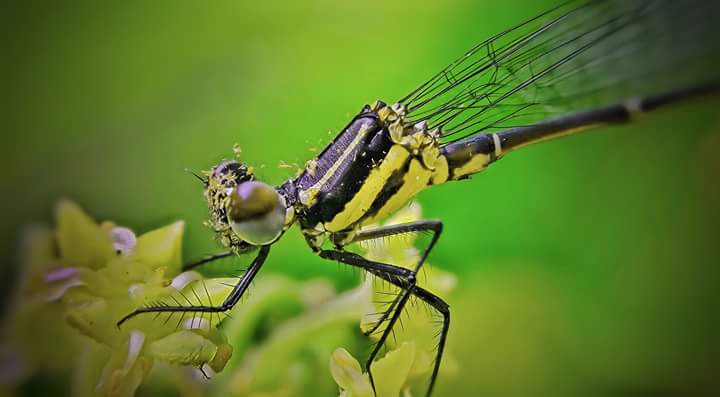A damselfly

The general body plan of a damselfly is similar to that of a dragonfly. The compound eyes are large but are more widely separated and relatively smaller than those of a dragonfly. Above the eyes is the frons or forehead, below this the clypeus, and on the upper lip the
labrum , an extensible organ used in the capture of prey . The top of the head bears three simple eyes ( ocelli ), which may measure light intensity, and a tiny pair of antennae that serve no olfactory function but may measure air speed. [6] Many species are sexually dimorphic ; the males are often brightly-coloured and distinctive, while the females are plainer,
cryptically coloured, and harder to identify to species. For example, in Coenagrion , the Eurasian bluets, the males are bright blue with black markings, while the females are usually predominantly green or brown with black. [7] A few dimorphic species show female-limited polymorphism, the females being in two forms, one form distinct and the other with the patterning as in males. The ones that look like males, andromorphs, are usually under a third of the female population but the proportion can rise significantly and a theory that explains this response suggests that it helps overcome harassment by males. [8] Some Coenagrionid damselflies show male-limited polymorphism, an even less understood phenomenon. [9]
In general, damselflies are smaller than dragonflies, the smallest being members of the genus Agriocnemis (wisps). [10] However, members of the Pseudostigmatidae (helicopter damselflies or forest giants) are exceptionally large for the group, with wingspans as much as 19 cm (7.5 in) in Megaloprepus[11] and body length up to 13 cm (5.1 in) in Pseudostigma aberrans.
nice ..man
Hi! I am a robot. I just upvoted you! I found similar content that readers might be interested in:
https://kids.kiddle.co/Damselfly
Nice post